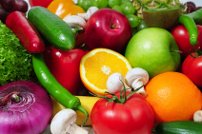Alkaline Foods and Acidic Foods
Our diet today tends to contain too many acidic foods and not enough alkaline foods. This causes a number of health problems.
Learn more about your health and the impact of alkaline foods and acidic foods.

Measuring Food Levels
The pH scale measures how acidic or alkaline a substance is. The scale ranges from 1 to 14 with 1 being very acid, 7 neutral and 14 very alkaline. Our body works the best and is the healthiest when it is at the optimal pH level. According to Dr. Christopher Vesey, N.D. our optimal pH is slightly alkaline and about 7.39.
Even though it is best to eat more alkaline foods, it doesn't mean that all of the acidic should be avoided. Instead they should be eaten in balance. Dr. Christopher Vasey, N.D. recommends eating 75-80% alkaline and the rest acidic.
Below is a list of foods, from Dr. Vasey's book, "The Acid-Alkaline Diet for Optimum Health."
Fruit
Most fruits are at a pH range from 5.5 - 7.5 and are alkaline. The exception is blueberries, cranberries, raspberries, nectarines, plums and prunes which are slightly acidic.
Vegetables
Most vegetables are alkaline except for tomatoes and eggplant.
Beans
Alkaline forming beans include green beans, lima beans, peas, snap peas, soybeans and string beans.
Acid forming beans include:
- aduki
- black
- broadbean
- garbanzo
- kidney
- lentils
- mung
- navy
- pinto
- red
- white
Nuts
Alkaline forming nuts include:
- almonds
- chestnuts
- coconut
- pignolias
Acid forming nuts include:
- brazil
- cashews
- filberts
- macademia
- peanuts
- pecans
- pistachio
- walnuts
Animal Products
Most animal products (meat, chicken, fish) are acidic, especially meat.
Egg yolks are alkaline, but whole eggs are acidic.
Dairy products such as raw, whole milk, soft unripened cheeses and fresh butter tend to be alkaline, but pasteurized milk and similiar products tend to be acidic.
Grains
Most grains are acid forming except for corn, amaranth, millet and quinoa which are more alkaline.
Vegetable Oils
Vegetable oils tend to be neutral or slightly alkaline. Avocado, olives and cold-pressed oils are alkaline.
Herbs
Green herbs are alkaline.
Sugars
The following sugars are alkaline forming:
- brown rice syrup
- dried sugar cane juice (sucanat)
- honey
These sugars are acid forming:
- artificial sweeteners
- white sugar
- processed honey
- maple syrup
- molasses
Beverages
The following beverages are acidic:
- coffee
- black tea
- soft drinks
- alcohol
Less acidic or alkaline beverages include:
- white or green tea
- herbal tea
